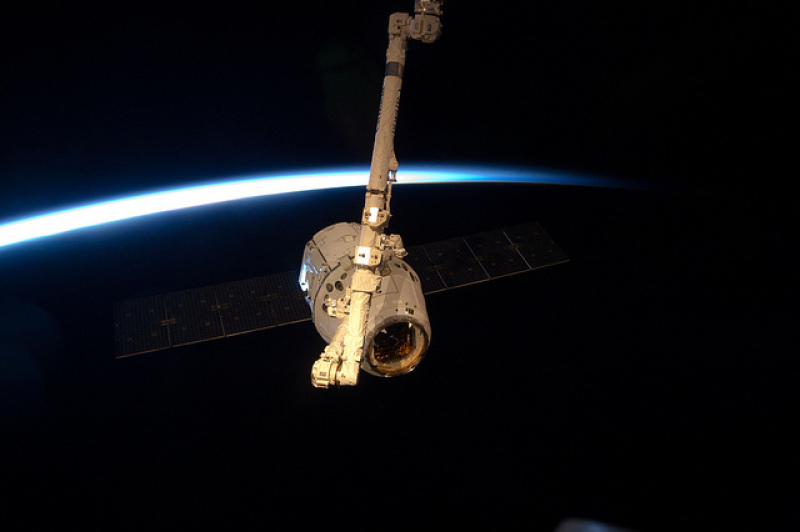

SpaceX performed its fifth successful cargo transport on Monday in its contract with NASA.
On Monday, SpaceX's cargo capsule successfully reached the International Space Station. At 2:54 am PST, the six-member crew at the International Space Station accepted the cargo into the station's port. SpaceX named their cargo ship Dragon; the vessel contained more than 5,000 pounds of supplies and science experiments.
The contents of Dragon were critical for the space crew, especially since two previous attempts to deliver cargo to the space station were unsuccessful. On October 28, a cargo rocket by Orbital Sciences that was destined for the space station exploded seconds after takeoff. The rocket was unmanned, as was SpaceX's craft, but the contents onboard were extremely valuable. Dragon's successful docking at the International Space Station is the first successful commercial cargo transfer in 2015.
"Thanks to our private sector partners, we've returned space station resupply launches to U.S. soil and are poised to do the same with the transport of our astronauts in the very near future. Today's launch not only resupplies the station, but also delivers important science experiments and increases the station's unique capabilities as a platform for Earth science with delivery of the Cloud-Aerosol Transport System, or CATS instrument. I congratulate the SpaceX and NASA teams who have made today's success possible. We look forward to extending our efforts in commercial space to include commercial crew by 2017 and to more significant milestones this year on our journey to Mars," said Charles Bolden, NASA Administrator, in a statement.
The flight was SpaceX's fifth successful cargo transport to the International Space Station under the $1.6 billion contract signed with NASA to taxi supplies to the station. Dragon contained 250 science experiments. The experiments include instruments to measure cloud and particle movements in the atmosphere to better understand earth's climate change, flatworms to research healing abilities in space, and fruit flies to study immune system abilities in space flight.
Besides the successful cargo transport, SpaceX achieved a large step forward in revolutionizing space travel. SpaceX landed the first stage rocket onto a platform, but the impact upon descent was too powerful and damaged some of the equipment inside the ship. The first stage rocket, called Falcon 9, of the resupply mission is part of SpaceX's attempt to reuse spacecraft after launch. Traditionally, spacecraft and rockets are burned upon reentering earth's atmosphere after launch and rendered unusable. SpaceX attempted to land the Falcon 9, which contained 9 thrusters, on a barge in the middle of the Atlantic Ocean just minutes after the launch. By using a system of hydraulics and fins, SpaceX hoped to land the Falcon 9 on an unmanned "autonomous spaceport drone ship". SpaceX was successful in previous soft landing tests on both land and sea, but this was the first time landing on a platform in the middle of the ocean. Reusing the spacecraft and engines would significantly reduce the costs of space travel, a dream of engineers and scientists.
SpaceX CEO Elon Musk compared the difficulty of the feat to balancing a rubber broomstick on the palm of one's hand during a windstorm.
"Rocket made it to the drone spaceport ship, but landed hard," tweeted Musk after the landing. "Close, but no cigar this time. Bodes well for the future tho."
Musk stated that the "ship itself is fine," and that though "some of the support equipment on the deck will need to be replaced," SpaceX has made "huge strides" in achieving reusable rockets.
He also stated that the reason for the harsh landing was due to a lack of hydraulic fluid moments before the landing, which was addressed with a 50 percent increase in the hydraulic fluid for the next attempt in February. The fins worked according to plan.


















